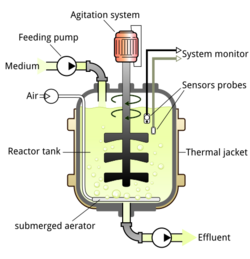Chemistry:Photofermentation
Photofermentation is the fermentative conversion of organic substrate to biohydrogen manifested by a diverse group of photosynthetic bacteria by a series of biochemical reactions involving three steps similar to anaerobic conversion. Photofermentation differs from dark fermentation because it only proceeds in the presence of light. For example, photo-fermentation with Rhodobacter sphaeroides SH2C (or many other purple non-sulfur bacteria[1]) can be employed to convert small molecular fatty acids into hydrogen[2] and other products.

Light-dependent pathways
Phototropic bacteria
Phototropic bacteria produce hydrogen gas via photofermentation, where the hydrogen is sourced from organic compounds.[4]
[math]\ce{ C6H12O6 + 6H2O ->[{hv}] 6CO2 + 12H2 }[/math][4]
Photolytic producers
Photolytic producers are similar to phototrophs, but source hydrogen from water molecules that are broken down as the organism interacts with light.[4] Photolytic producers consist of algae and certain photosynthetic bacteria.[4]
[math]\ce{ 12H2O ->[{hv}] 12H2 + 6O2 }[/math](algae)[4]
[math]\ce{ CO + H2O ->[{hv}] H2 + CO2 }[/math](photolytic bacteria)[4]
Sustainable energy production
Photofermentation via purple nonsulfur producing bacteria has been explored as a method for the production of biofuel.[5] The natural fermentation product of these bacteria, hydrogen gas, can be harnessed as a natural gas energy source.[6][7] Photofermentation via algae instead of bacteria is used for bioethanol production, among other liquid fuel alternatives.[8]
Mechanism
The bacteria and their energy source are held in a bioreactor chamber that is impermeable to air and oxygen free.[7] The proper temperature for the bacterial species is maintained in the bioreactor.[7] The bacteria are sustained with a carbohydrate diet consisting of simple saccharide molecules.[9] The carbohydrates are typically sourced from agricultural or forestry waste.[9]
Variations
In addition to wild type forms of Rhodopseudomonas palustris, scientists have used genetically modified forms to produce hydrogen as well.[5] Other explorations include expanding the bioreactor system to hold a combination of bacteria, algae or cyanobacteria.[7][9] Ethanol production is performed by the algae Chlamydomonas reinhardtii, among other species, in cycling light and dark environments.[8] The cycling of light and dark environments has also been explored with bacteria for hydrogen production, increasing hydrogen yield.[10]
Advantages
The bacteria are typically fed with broken down agricultural waste or undesired crops, such as water lettuce or sugar beet molasses.[11][5] The high abundance of such waste ensures the stable food source for the bacteria and productively uses human-produced waste.[5] In comparison with dark fermentation, photofermentation produces more hydrogen per reaction and avoids the acidic end products of dark fermentation.[12]
Limitations
The primary limitations of photofermentation as a sustainable energy source stem from the precise requirements of maintaining the bacteria in the bioreactor.[7] Researchers have found it difficult to maintain a constant temperature for the bacteria within the bioreactor.[7] Furthermore, the growth media for the bacteria must be rotated and refreshed without introducing air to the bioreactor system, complicating the already expensive bioreactor set up.[7][9]
See also
- Dark fermentation
- Fermentative hydrogen production
- Biohydrogen
- Fermentation (biochemistry)
- Hydrogen production
- Photochemical reaction
- Photohydrogen
- Phototroph
- Photobiology
- Electrohydrogenesis
- Microbial fuel cell
References
- ↑ "Integrating dark and light bio-hydrogen production strategies: towards the hydrogen economy.". Reviews in Environmental Science and Bio/Technology 8 (2): 149–185. June 2009. doi:10.1007/s11157-008-9144-9. http://pure-oai.bham.ac.uk/ws/files/2922596/Redwood-Patterson-Macaskie_RESTEch_2009_ePrint.pdf.
- ↑ "High hydrogen yield from a two-step process of dark-and photo-fermentation of sucrose.". International Journal of Hydrogen Energy 32 (2): 200–6. February 2007. doi:10.1016/j.ijhydene.2006.06.034.
- ↑ Gabrielyan, Lilit; Sargsyan, Harutyun; Trchounian, Armen (2015-09-04). "Novel properties of photofermentative biohydrogen production by purple bacteria Rhodobacter sphaeroides: effects of protonophores and inhibitors of responsible enzymes" (in En). Microbial Cell Factories 14 (1): 131. doi:10.1186/s12934-015-0324-3. ISSN 1475-2859. PMID 26337489.
- ↑ Jump up to: 4.0 4.1 4.2 4.3 4.4 4.5 "A review on dark fermentative biohydrogen production from organic biomass: Process parameters and use of by-products". Applied Energy 144: 73–95. April 2015. doi:10.1016/j.apenergy.2015.01.045.
- ↑ Jump up to: 5.0 5.1 5.2 5.3 "Biotransformation of water lettuce (Pistia stratiotes) to biohydrogen by Rhodopseudomonas palustris". Journal of Applied Microbiology 123 (6): 1438–1446. December 2017. doi:10.1111/jam.13599. PMID 28972701.
- ↑ "Utilization of distillery wastewater for hydrogen production in one-stage and two-stage processes involving photofermentation". Enzyme and Microbial Technology 110: 1–7. March 2018. doi:10.1016/j.enzmictec.2017.11.009. PMID 29310850.
- ↑ Jump up to: 7.0 7.1 7.2 7.3 7.4 7.5 7.6 "Bioreactor design for photofermentative hydrogen production". Bioprocess and Biosystems Engineering 39 (9): 1331–40. September 2016. doi:10.1007/s00449-016-1614-9. PMID 27142376.
- ↑ Jump up to: 8.0 8.1 "Prospective technology on bioethanol production from photofermentation". Bioresource Technology 181: 330–7. April 2015. doi:10.1016/j.biortech.2015.01.090. PMID 25678298.
- ↑ Jump up to: 9.0 9.1 9.2 9.3 "Photo-fermentative hydrogen production from crop residue: A mini review". Bioresource Technology 229: 222–230. April 2017. doi:10.1016/j.biortech.2017.01.008. PMID 28108074.
- ↑ "Biohydrogen production using sequential two-stage dark and photo fermentation processes". International Journal of Hydrogen Energy 33 (18): 4755–4762. September 2008. doi:10.1016/j.ijhydene.2008.06.055.
- ↑ "Hydrogen production from sugar industry wastes using single-stage photofermentation". Bioresource Technology 112: 131–6. May 2012. doi:10.1016/j.biortech.2012.02.077. PMID 22420990.
- ↑ "Biohydrogen production: strategies to improve process efficiency through microbial routes". International Journal of Molecular Sciences 16 (4): 8266–93. April 2015. doi:10.3390/ijms16048266. PMID 25874756.
External links
- Photo fermentation
- Enhancing phototropic hydrogen production by solid-carrier assisted fermentation and internal optical-fiber illumination
 |



